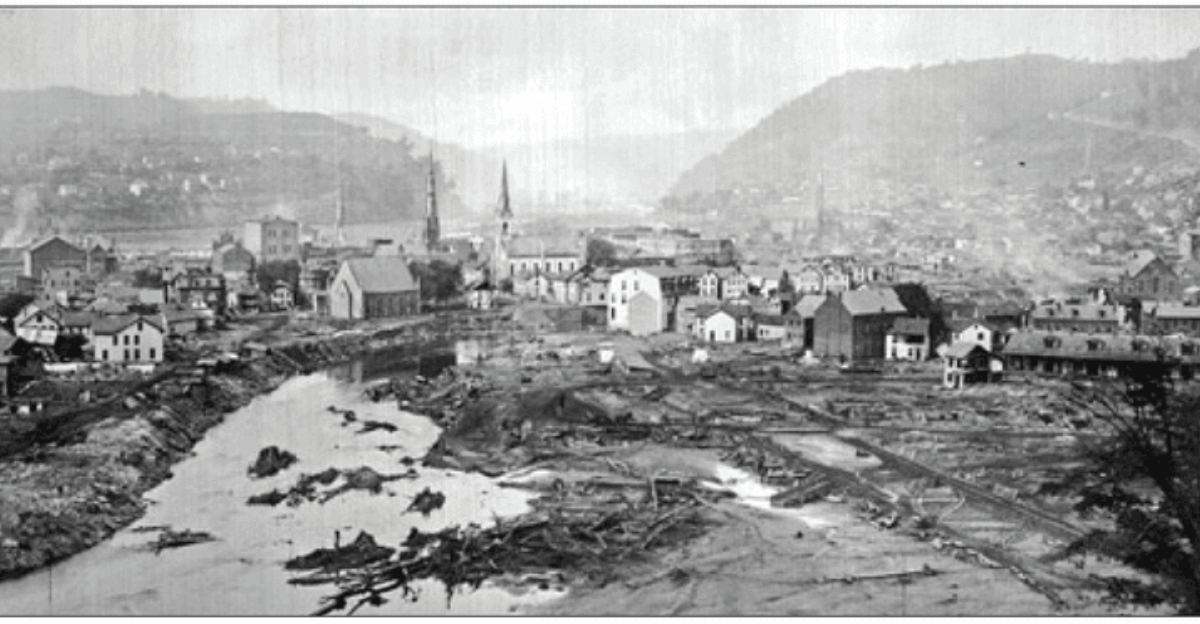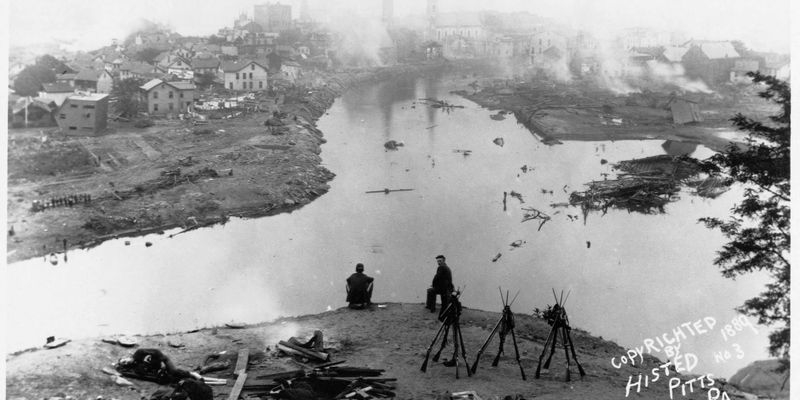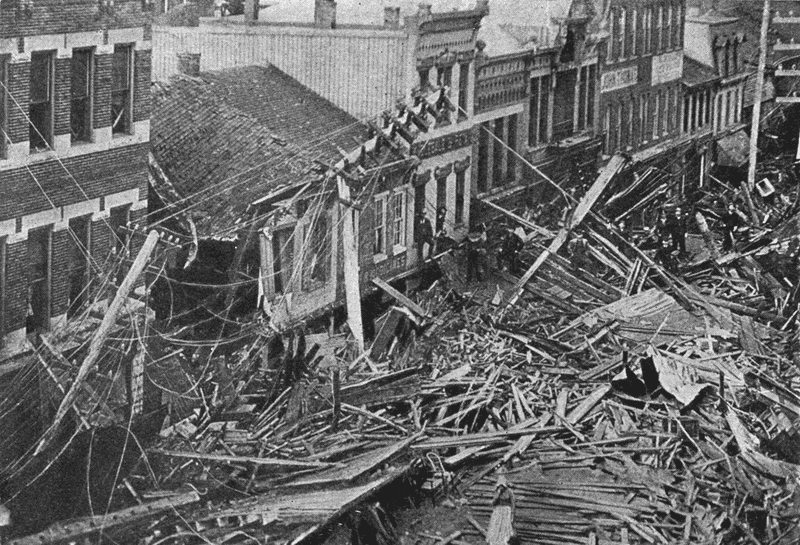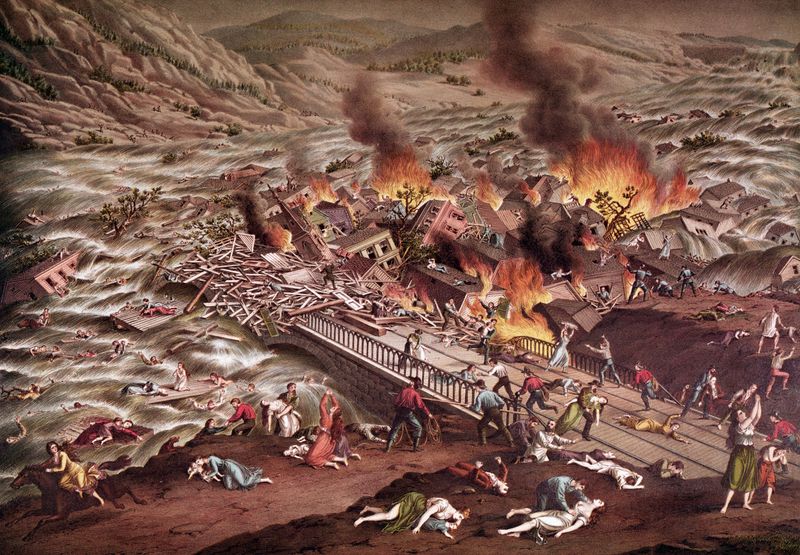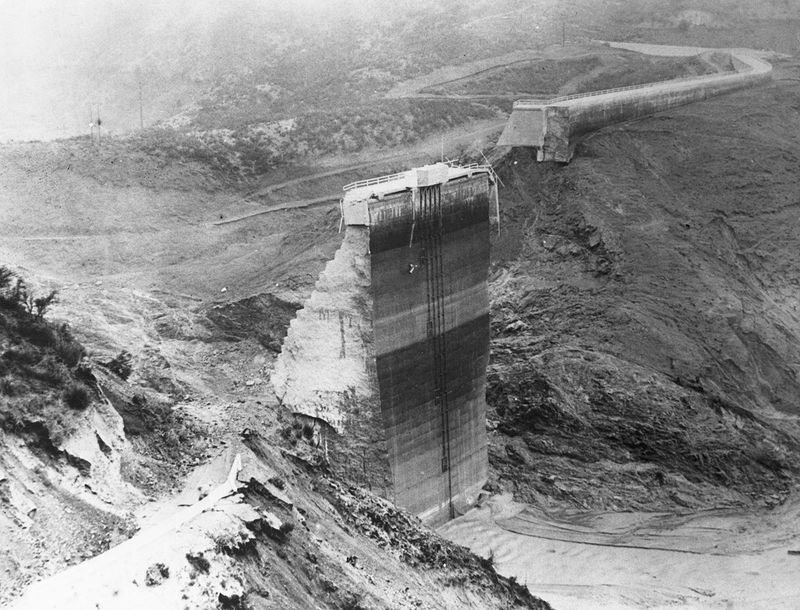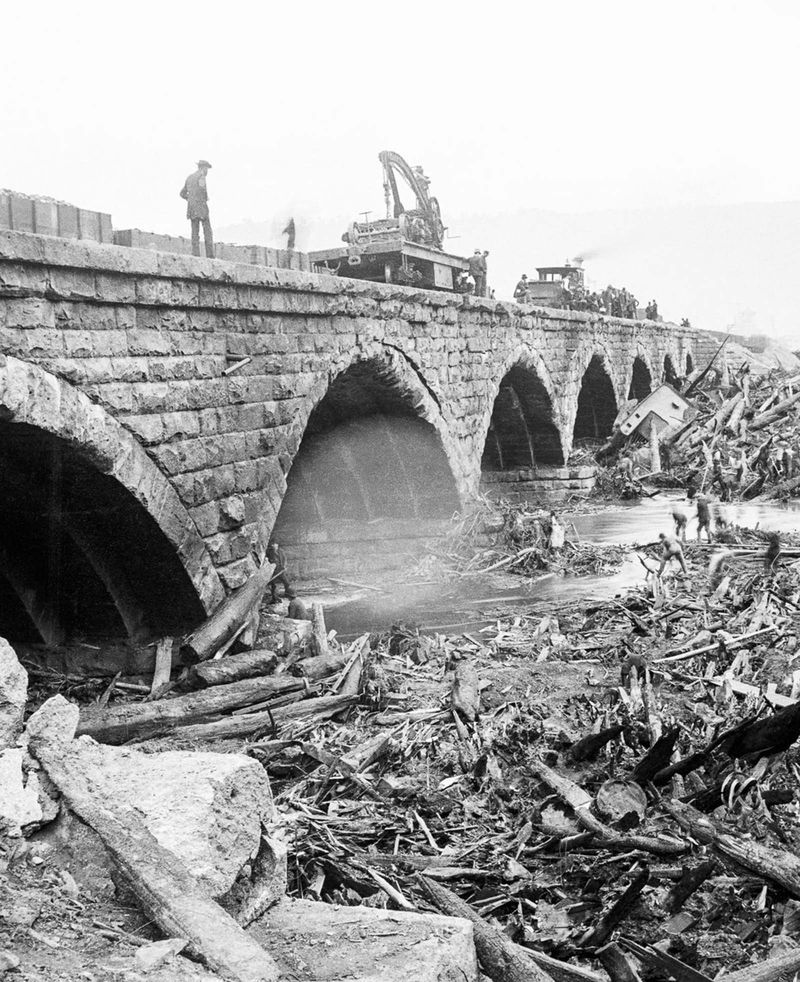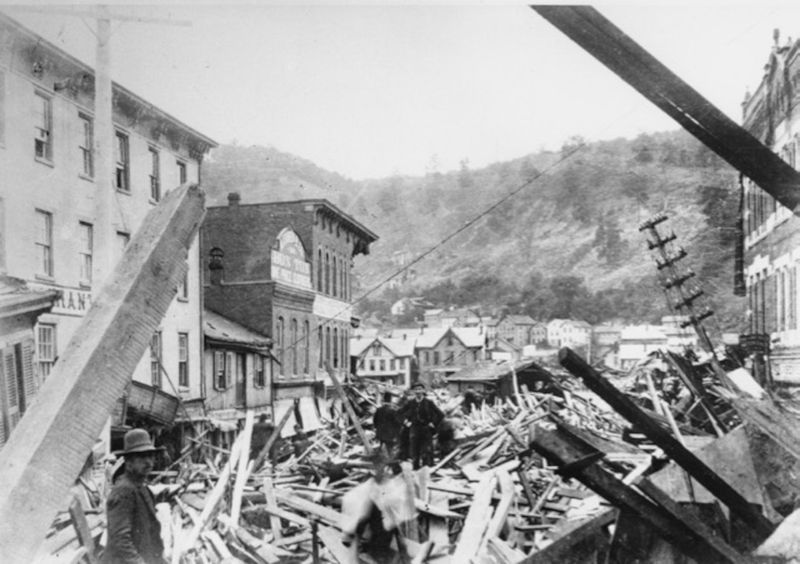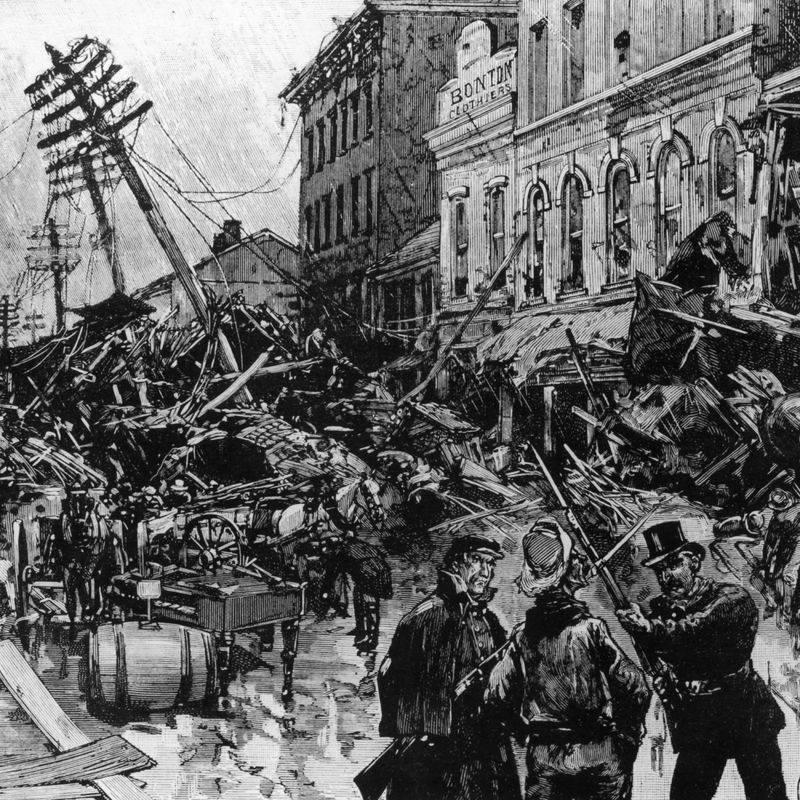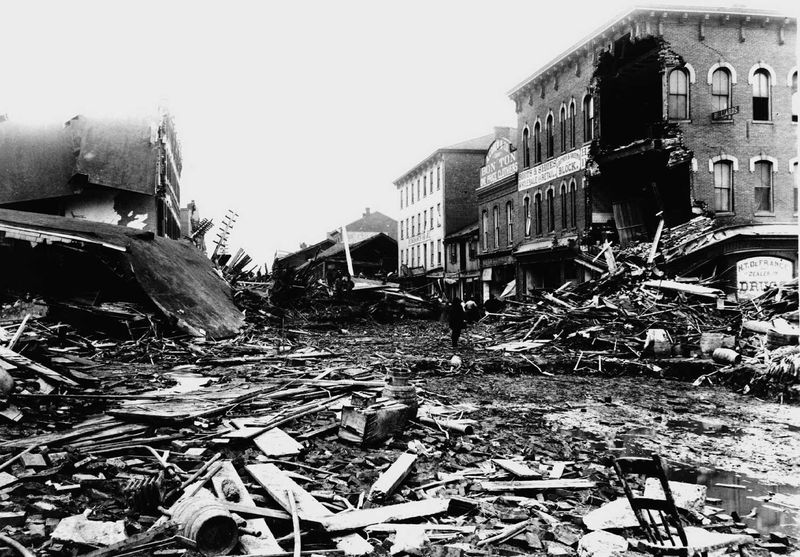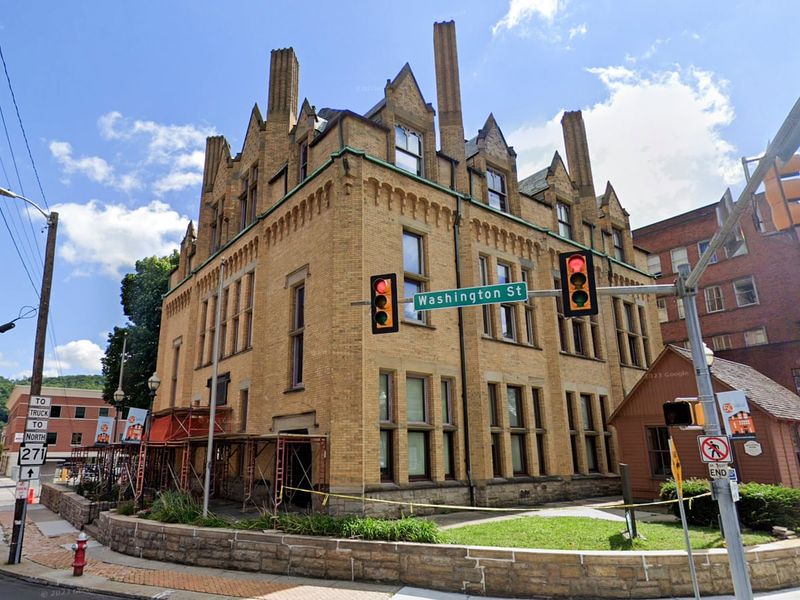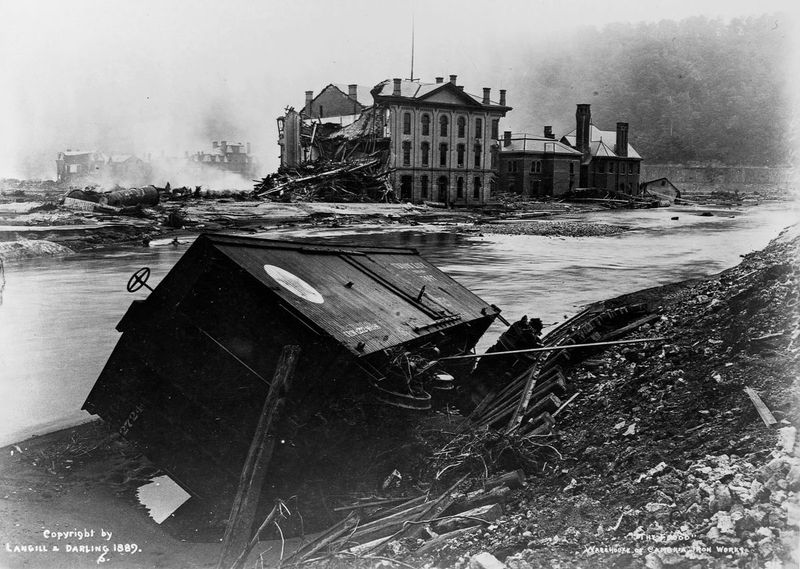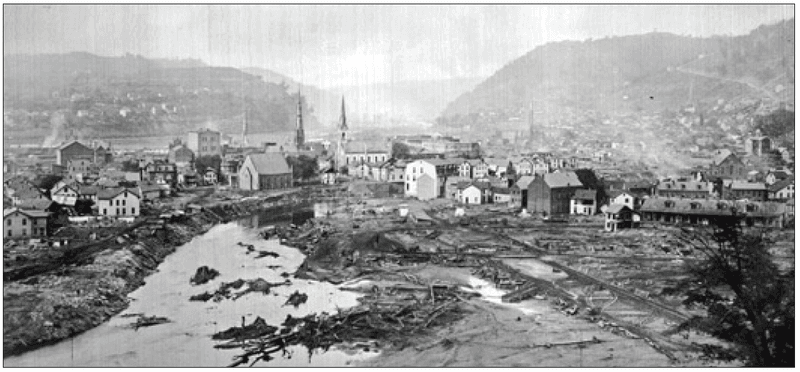On May 31, 1889, a wall of water obliterated Johnstown, Pennsylvania, killing over 2,200 people in one of the most horrifying tragedies in American history. More than a century later, the Johnstown Flood remains a haunting example of human negligence and nature’s fury. Here are the most chilling facts you need to know about America’s deadliest dam disaster.
1. A Dam Built for the Elite Became a Death Trap
Originally constructed to provide water for a canal system, the South Fork Dam was later acquired by a private hunting and fishing club for wealthy industrialists—including Andrew Carnegie and Henry Clay Frick. The modifications they made severely weakened the dam’s safety. The dam’s integrity was compromised by alterations intended to benefit the club’s elite members. These changes included the lowering of the dam to build a road across it. This reduced spillway capacity significantly increased the risk of overflow during heavy rains. The dam’s transformation from a practical structure into a luxury amenity set the stage for disaster.
2. Warnings Were Ignored for Years
Local engineers and residents had repeatedly warned that the dam was unsafe. It had experienced multiple leaks, and the owners had lowered its height to build a road across it—making overflow far more likely. Despite these alarming signs, the warnings went unheeded. The altered dam was a ticking time bomb, waiting for the perfect storm to unleash its fury. Ignoring the danger signs and credible alerts, the club members prioritized their leisure over safety. This negligence left Johnstown vulnerable to impending disaster, a stark reminder of the consequences of ignoring expert advice and community concerns.
3. The Day It Broke, the Sky Opened Too
Torrential rains pummeled western Pennsylvania in the days leading up to the disaster. The dam—already in poor condition—couldn’t handle the pressure and gave way shortly after 3:00 p.m. on May 31. The deluge added colossal weight to the already stressed dam structure. Nature’s relentless assault provided the final blow to a neglected and weakened dam. As the skies unleashed their fury, the dam stood no chance. This weather event of epic proportions spelled doom for the town below. Johnstown was about to face a tragedy of unprecedented scale due to the lethal combination of rain and human negligence.
4. A 40-Foot Wall of Water Moved at 40 MPH
The flood surge swept down the narrow valley toward Johnstown, 14 miles away. Traveling at terrifying speeds, it flattened homes, trees, trains, and entire buildings in minutes. This wall of water moved with the force of a freight train, carrying debris and destruction in its wake. It was an unstoppable juggernaut, obliterating everything in its path. The sheer power and speed of the water rendered any resistance futile. As it thundered through the valley, the devastation it wrought was total and absolute. Johnstown had little time to prepare or react as chaos descended upon it swiftly and violently.
5. A Whirlpool of Death at the Stone Bridge
As the flood hit Johnstown, it slammed into a stone railroad bridge, creating a deadly logjam that caught debris and trapped victims. Fires erupted in the tangled mess, burning many people alive. This bridge became a sinister focal point of destruction. The debris acted as a dam, causing water levels to rise upstream and creating a whirlpool of death. Adding to the horror, fires ignited due to overturned stoves and lanterns, turning the scene into a fiery inferno. The bridge, meant to withstand the test of time, became a witness to one of the darkest moments in Johnstown’s history.
6. Entire Families Were Wiped Out
Thousands of people had no time to react. Families were washed away in their homes, and children were separated from parents. Some survivors recounted seeing bodies floating for miles. The human toll was catastrophic, with entire families perishing in the deluge. The floodwaters were swift and merciless, displacing loved ones and leaving a trail of unimaginable grief. The separation of families added to the devastation, as the survivors faced the grim task of identifying bodies. The flood not only claimed lives but shattered the social fabric of the community, leaving indelible scars on the survivors and the town itself.
7. A Town Flattened in Minutes
Johnstown was nearly erased from the map. More than 1,600 homes and 280 businesses were destroyed. Trains were tossed like toys, and locomotives were found a mile from the tracks. The once-thriving town lay in ruins, a testament to the devastating power of the floodwaters. The sheer scale of destruction was overwhelming, with entire neighborhoods obliterated in a matter of minutes. The aftermath resembled a war zone, with rubble stretching as far as the eye could see. The town faced an uphill battle to rebuild, but the spirit of its people remained unbroken, determined to rise from the ashes.
8. 99 Entire Families Were Never Reunited
Among the dead were 396 children. In all, 99 families were completely wiped out—no survivors, no descendants. The flood left a void that could never be filled, with generations lost in an instant. The tragedy of these families, who once shared hopes and dreams, was magnified by their complete erasure from the community. The survivors bore the burden of memory, carrying forward the legacy of those who perished. This loss was a poignant reminder of the fragility of life and the indiscriminate nature of disaster. The stories of these families are etched in history as a somber testament to their existence.
9. The Relief Effort Was the First Major U.S. Disaster Response
The American Red Cross, led by Clara Barton, mounted its first major relief operation here. Barton’s efforts would lay the groundwork for future national disaster response systems. The response was a beacon of hope amid the tragedy, showcasing the resilience and compassion of the human spirit. Volunteers worked tirelessly, providing medical care, food, and shelter to the displaced. This operation marked a turning point in disaster relief, setting a precedent for organized and effective humanitarian aid. Barton’s leadership and dedication left a lasting legacy, transforming the way the nation responds to crises and providing a template for future efforts.
10. No One Was Held Legally Responsible
Despite overwhelming evidence of negligence, none of the South Fork Fishing and Hunting Club members were ever held accountable. The courts ruled it a natural disaster—setting a chilling precedent. The verdict was a bitter pill for the survivors, who sought justice for their unimaginable losses. The legal system’s failure to assign responsibility left a void, eroding trust in institutions meant to uphold justice. This decision underscored the power dynamics at play, where wealth and influence shielded the culpable. The ruling remains a stark reminder of the challenges in holding powerful entities accountable, and the continuing fight for justice and accountability.
11. Survivors Rebuilt, But the Trauma Never Left
The people of Johnstown rebuilt their town from the rubble, but the scars remained. Many survivors suffered from what we’d now recognize as PTSD. The community’s resilience was inspiring, as they banded together to restore their homes and lives. However, the emotional wounds were deep, with memories of the disaster haunting them long after the physical rebuilding was complete. Nightmares, anxiety, and grief became part of the survivors’ daily struggles. Despite the challenges, the spirit of Johnstown endured, a testament to human perseverance in the face of adversity. The story of resilience became as much a part of Johnstown’s identity as the flood itself.
12. The Johnstown Flood Museum Preserves the Memory
Today, a museum and National Memorial honor the victims and document the event with artifacts, photographs, and survivor stories. This preservation effort serves as a constant reminder of the past, ensuring that the lessons learned are not forgotten. The museum provides a space for reflection and education, allowing visitors to connect with the stories of those who lived through the disaster. The exhibits highlight the human aspects of the tragedy, offering a glimpse into the lives of those affected. Through these displays, the museum keeps the memory of the flood alive, fostering a sense of historical continuity and awareness.
13. Bodies Were Found as Far Away as Cincinnati
The floodwaters carried bodies and debris hundreds of miles downstream. Some remains weren’t discovered for months—and some were never found. The vast reach of the disaster extended far beyond Johnstown, affecting communities along the rivers. The search for victims was an arduous and heart-wrenching task, with families holding onto hope for news of their loved ones. The distance traveled by the floodwaters highlighted the enormity of the tragedy, as its impact was felt across multiple states. This widespread devastation underscored the interconnectedness of communities and the far-reaching consequences of human and natural actions.
14. It Inspired Legislation—but Not Fast Enough
Though the tragedy sparked calls for stricter dam safety laws, real reform took decades. In the meantime, other dam failures occurred—with preventable loss of life. The delay in enacting change was a missed opportunity to prevent further disasters. The lessons from Johnstown were clear, yet the wheels of bureaucracy turned slowly. This lag in legislative action reflected the challenges of translating tragedy into policy. The eventual reforms were a step forward, but the time lost could not be recovered. The legacy of the flood became a catalyst for change, urging society to prioritize safety and responsibility in infrastructure management.
15. Hollywood Brought It to the Big Screen
The flood has been the subject of several films and documentaries, most famously in the 1926 silent film The Johnstown Flood, which dramatized the catastrophe. This cinematic portrayal introduced the story to a wider audience, preserving its memory through the medium of film. The dramatization captured the disaster’s intensity, bringing the past to life for viewers. While the film took creative liberties, it stayed true to the essence of the event, highlighting the heroism and tragedy experienced by the people of Johnstown. Through cinema, the flood’s story transcended time, continuing to inform and engage new generations.
16. A 2,209-Person Death Toll That Still Stands
To this day, the Johnstown Flood remains the deadliest dam-related disaster in U.S. history. Its sheer scale is almost unimaginable—and serves as a cautionary tale for future generations. The magnitude of the loss is etched in the annals of history, a somber benchmark against which other disasters are measured. The memory of the thousands who perished is honored through memorials and ongoing historical research. This tragic event is a stark reminder of the collective responsibility to safeguard lives through diligent infrastructure management and oversight. The legacy of the flood endures, urging vigilance and accountability in the face of potential hazards.
17. A Town Erased, But Never Forgotten
Johnstown still stands today, a living monument to resilience. Each May 31, the town remembers those who were lost in the disaster that changed everything in a matter of minutes. The community’s annual remembrance is a poignant tribute to the lives lost and the spirit of survival. These commemorations serve as a bridge between the past and present, honoring the town’s history while celebrating its rebirth. The resilience of Johnstown is reflected in its people and their determination to preserve the memory of the flood. This enduring legacy is a testament to the town’s strength and commitment to never forget its past.
